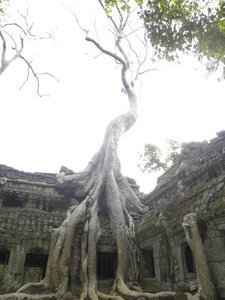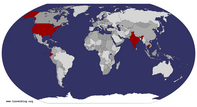Advertisement
Published: January 19th 2011

 Ta Prom
Ta Prom
The famous tree roots eating away at Ta PromSo I realized the last post was a bit heavy, so I thought I'd make this one about other parts of the culture, people, and life in general here.
So, first off, this is only my second 3rd world country, and they are definitely not all alike. I know I'm not the only one to make this comment, so while generalizations are of course by definition... generalized =P Cambodians overall seem to be a very friendly and cheerful people! They tend to smile at you more often, they don't harrase you to buy things nearly as much as they did in India (and from what my friends have told me, Thailand or Vietnam), and I've really seem very few beggars in Siem Reap. While there's the same tendency to want to want to overcharge foreigners and haggling is the rule, not the exception, so far at least we seem quite welcome here.
Everything here is truly inexpensive, and Cambodians in general are really quite poor. The local currency is actually the American dollar, with riels ($1 = appromxiately 4000 riel) used only for small change. Most of our meals cost from $1.50 - $3 (with street vendor food usually
costing about $1 for foreigners), draft beer is usually 50 cents, cocktails are $3, and fruit shakes and such that you get in the US for $3 are at $1 - $1.50. And those are the elevated prices for foreigners! I ate with a Cambodian doctor at a local, more rural restaurant the other night, and each of our meals (stir fried noodles and a drink) cost $1 since we got the Cambodian price! This is, of course, because in general the Cambodians are quite poor. A tuk tuk ride from the center of town to our guest house (about a 15 min walk) costs $1, and everywhere you go they are calling out to you to ask if you want a tuk tuk. (For those who are unfamiliar, a tuk tuk is basically like a small carriage being pulled by a motorbike. It is the most common method of transport if you don't have your own moto (as most of the middle class do), or if you're rich, a car. There's also a wonderful mix of food here. The one big touristy restuarant street here is called Pub Street, and you can find anything from Kmer to Indian to
Mexican to various "happy" pizzas (aka made with weed as topping, which apparently is a sure fire way to take a bad trip as ingesting the stuff makes it way too strong and you're basically incapacitated for several hours after). There are also numerous bars on the street (again different from India) including an "Irish bar" called Molly Mallone's, but which is probably about as Irish inside as a ham sandwich, except that they happen to sell whisky! Just about the first bar in Siem Reap (still there now, and quite popular, given Siem Reap was really only built up in the last 5-6 years) is called Angkor What, which I think is a pretty clever play on the most popular attraction in the area. It looks rather like a bar you'd likely find back home, with graffiti decorations all over the walls, people's names covering the columns, and "buckets" of various alcoholic concoccions on special for about $2-3. They also have wonderfully cheap massages all over the roads here. A one hour massage is generally $5, a little bit more if you want oil with it, and then they have a 4 hand massage, feet massages, and all sorts
of spa type treatments for a good less than 10th of the price you'd find in the States. Plus, you don't tip here! One of the more worthwhile places is a chain that's called Seeing Hands, which features massage by the blind. I had one today, actually, and it was Shiatsu method. The room was pretty plain and there were basically a bunch of massages tables all laid out together. It wasn't fancy by any means - no music, no incense, no undressing even they just do it over your clothes and place a towel over whichever area they will be working on, but all for a very good cause for $6. I like it when people don't just decide they're disabled and give up and actually try and work for a living, you know? The Cambodians are, however, as far as I can tell, a very hardy people. They probably have to be, considering the history they've been though, but they're truly not a people to complain and roll over. At the Ankor Wat temples and on Pub Street you'll find people who have been maimed by the mines playing traditional Cambodian music, sometimes with only parts of limbs
somehow holding onto the bow and stringing away! The two patients who I've stuck for lumbar punctures here endured the procedure without any pain medication without complaint and without flinching or moving once! (For the non medical the lumbar puncture is a procedure where you stick a needle into someone's spine to remove spinal fluid to test for infection. In first world countires you'd never think of doing it without some sort of pain medication...) Some friends who work at a maternity center tell me that the women there all deliver without any pain medications whatsoever as well, which honestly is just amazing to me. Quite frankly that's enough reason right there to simply not have kids at all! =P
As for Cambodia's probably only famous attraction, Angkor Wat and the other surrounding temples, they are truly quite remarkable. I went on tour last weekend and saw about 8 temples in one day, and decided I'm just about templed out for awhile now... They were built over a long time period, but were approximately 1000 yrs ago by the kings of the Angkor kingdom, which at one point ruled over the current areas of Thailand and Vietnam (if I'm
remembering this correctly). By mythology (per my guide) Cambodia was made when the great serpent drank up all the water in this area of the ocean to make a piece of land to use as dowry for his daughter, who was to be married. (Apparently scientists think it was made by volcano, but that doesn't make for as good a story =P ) The serpent and the lion are very important figures in Angkorian iconography, you'll find them everywhere. Anyway, each king had to build at least 1 temple during his reign as a thanking/worship to the god/gods (seeing as they were a mix of Hindu and Buddhist), hence all the many temples. All the Hindu temples are built in such a way as to represent a mountain, and thus all look a bit like pyramids, while the Buddhist temples, though they might be on platforms, are all more or less flat. Sadly because of the two conflicting religions there was a lot of temple defiling done during the Angkor reign itself, such that many of the Hindu statues/carvings on any preceeding temples were defaced/removed during the periods when Buddhism preavaled, and vice versa for Hindu predominance, and then what
makes the least sense to me is that more recently some of the statues/carvings have been removed to put in museums in France and in Phnom Phen?? Why would you deface a monument or cut out a square of a carving leaving an ugly hole, just to put some little piece of it in a museum hundreds of miles away?? Anyway, Angkor Wat is the biggest of the temples, encompassing an area that would be big enough for a palace, really, complete with 2 reflecting pools, 4 libraries, and halls of carved murals that stretch a good 100 meters or so, which tell various stories from Cambodian history and mythology. Apparently at the time there were about 3 million people in Cambodia, and so to build it the king declared that everyone must spend 3 months of their lives working on the project. I think he said it took them about 45 years, but it was actually never completely finished, as far as the decorations on the walls. There are still areas where you can see the outline of decorations they were once to put in, but never got around to. Bayon is probably one of the next most famous
temples, seeing as it too is impressively large, and has four Buddha faces on every tower - one for each of the things the king felt were needed to rule. Sadly the only ones I remember right now are compassion and empathy, but good things for the king, no? In addition the numbers 5, 7, and 9 were lucky according to Angkor tradition, so somehow they worked out the number of towers, the number of eyes on the faces, etc to all come out in multiples of those 3 numbers. The last temple most people who've looked at Angkor Wat pictures have probably seen is Ta Prom, which is the temple being eaten away by the jungle that is most visited. In truth most of it has been cleared away leaving only the artistically/structurally interesting confluences of jungle and temple, but it's much closer then the so called Indiana Jones type temple that is a good hr away or so.
The other most popular sites around Siem Reap are the floating villages. Basically little communities of houses on rafts that I assume must be anchored down somehow? Everyone, including little children who look to be about 6 or 7
(though Cambodian children often look younger then they are, secondary to malnutrition) row about on little boats between each other and to school, work, etc. Some of the boats we saw had 2 children in them, 1 steering and the other madly trying to scoop the water out of the boat! Some of the villages also have little floating gardens to seem to be attached to the house, and as far as I can tell the people tend to be farmers, fishermen, a couple have fish farms, and then rest maybe go into the city? Not sure. I'm hoping to be able to attach pictures of both this and Angkor Wat before I go home...
Anyway, enough of a blurb for now! More adventures/insights to come. =)
Advertisement
Tot: 0.069s; Tpl: 0.012s; cc: 6; qc: 52; dbt: 0.0422s; 1; m:domysql w:travelblog (10.17.0.13); sld: 1;
; mem: 1.2mb









Dara C
non-member comment
Very interesting.. I wonder if the concept of taking pieces of monuments out to display at foreign museums is a result of a lack of advocacy; can you imagine if someone suggested they carve a chunk out of Mt. Rushmore and haul it off to a museum overseas?! When you mentioned the blind masseurs I thought of Slumdog Millionaire, and the children who were blinded to become more efficient beggars.. But, I certainly hope that's not the case with the folks you encountered!